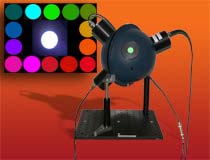Portable ’rainbow’ source improves color calibrations

NIST’s new portable "rainbow" source for calibrating color measurement instruments. In the background are a sampling of colors generated with the source.
If you need bright blue light at a very specific wavelength, the National Institute of Standards and Technology (NIST) can make it—and fast.
In the world of color, this is no small accomplishment. NIST’s traditional light sources, such as incandescent lamps, are thermal. A blue thermal source would need to function at such a high temperature that components would melt. Lack of blue light sources introduces uncertainty when calibrating instruments that measure the color of things like bright stars or the open ocean. Knowing the exact color is important because it allows scientists, for example, to use remote satellites to judge the concentration of plant life in the ocean, which in turn affects global climate.
Now NIST has developed a “rainbow source” that can be tuned across the entire visible light spectrum, from red to blue light. This unique source exploits recent materials advances in light-emitting diodes (LEDs) of different colors. By mixing exact percentages of LEDs at different wavelengths of visible light with the desired brightness, the optical properties of the source (such as the color) can be changed and tailored for a particular application. The source uses commercial LEDs. NIST researchers characterized them and developed the packaging, electronics and software. In addition, the tunable light source is highly portable: It is a sphere about 30 cm (1 foot) in diameter and weighs about two kilograms (5 pounds). Battery operated versions have been developed for field applications.
NIST researchers described the invention at the Ocean Color Research Team Meeting in Washington, D.C. on April 14. The National Oceanic and Atmospheric Administration has ordered a simplified version of the rainbow source to reduce uncertainties in calibrations of a satellite that measures ocean color, as part of a program that monitors the carbon balance between the ocean and atmosphere. The source also could simplify color calibrations in industrial and other research applications.
Additional details will be presented at a meeting at NIST in Gaithersburg, Md., on May 10-14 sponsored by NIST, the InterSociety Color Council, and the Council for Optical Radiation Measurements.
Media Contact
More Information:
http://www.nist.gov/All latest news from the category: Power and Electrical Engineering
This topic covers issues related to energy generation, conversion, transportation and consumption and how the industry is addressing the challenge of energy efficiency in general.
innovations-report provides in-depth and informative reports and articles on subjects ranging from wind energy, fuel cell technology, solar energy, geothermal energy, petroleum, gas, nuclear engineering, alternative energy and energy efficiency to fusion, hydrogen and superconductor technologies.
Newest articles

How the Immune System Learns from Harmless Particles
Our lungs are bombarded by all manner of different particles every single day. Whilst some are perfectly safe for us, others—known as pathogens—have the potential to make us ill. The…

Biomarkers identified for successful treatment of bone marrow tumours
CAR T cell therapy has proven effective in treating various haematological cancers. However, not all patients respond equally well to treatment. In a recent clinical study, researchers from the University…

She deciphers how tomato roots communicate
Ora Hazak has always been fascinated by plants and is studying the signals that roots send to the rest of the organism. She aims to understand this communication in order…





















